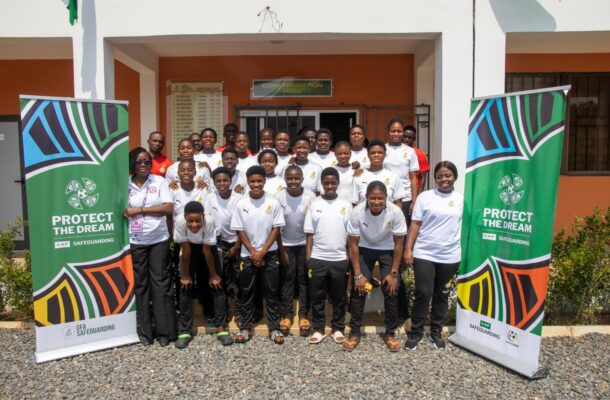In memory of Akpene Adzo Ahadzie: Why Ghana must show commitment to SDG 11.2 -Professor Divine Ahadzie writes
THE SHOCK, PAIN AND GRIEF On Tuesday 9th July 2024, I had barely gotten home in the evening and while watching the 7 pm news, we received a call that our beloved daughter, Akpene Adzo Ahadzie, a 6th-year Architecture student at KNUST had been involved in an accident and was in ‘stable condition’ at the […]

THE SHOCK, PAIN AND GRIEF
On Tuesday 9th July 2024, I had barely gotten home in the evening and while watching the 7 pm news, we received a call that our beloved daughter, Akpene Adzo Ahadzie, a 6th-year Architecture student at KNUST had been involved in an accident and was in ‘stable condition’ at the KNUST hospital. We rushed to the scene only to find out that, our daughter who was home on Monday evening July 8, 2024, after visiting for the weekend had passed away, following a road traffic accident involving a vehicle and herself on a bicycle.
“To say we as a family are devastated and traumatised is, to say the least, a huge understatement”. We are indeed in shock, pain and shattered as a family. How can a vehicle knock down a cyclist on a quiet residential road within the university campus to her instant death? Our beloved Adzo met her untimely death on the stretch between the KNUST Great Hall descending the lane to the residential area via the Staff Club House. This is how some media outlets, including the Voice of KNUST, reported the incident on X (formerly Twitter).
“On Tuesday evening, Adzo Ahadzie, KNUST 6th-year Master of Architecture student was knocked down by a vehicle while riding on her bicycle along the Club House Road, KNUST.”
Having lived on the University campus as a family for close to 15 years before relocating outside, Adzo, like other children who lived on the campus, was overly familiar with this route and along with many other children who lived on campus, often enjoyed riding bicycle on this popular stretch several times in her adolescent years. I must say that during my youthful days on campus in the 1980s, also enjoyed bicycle riding on that same stretch.
And so, finding children riding bicycles on campus is no news. Though the road is not busy, it must be said that occasionally some overzealous motorists have been careless by overspeeding along that route; especially with increasing mobility activities on the campus as a result of the vast expansion. Following the traffic incident involving Adzo, I have had one or two colleagues from the University, who on visiting to sympathise with the family, narrated their involvement in a near-fatal crash of their vehicles, attributed to overzealous drivers using the same stretch.
MY EXPERIENCE DRIVING ON THE SAME STRETCH OF ROAD A WEEK BEFORE ADZO DIED WHILE RIDING
With the increasing student population and attraction of the greenery of the KNUST campus, there are now often more pedestrian engagements on that stretch with activities such as photo shoots of married couples, and bicycle and roller skate riding, among other forms of sustainable mobility for fun and extra-curricular activities. That said, a week before the tragic incident involving Adzo, I drove along the same route to the Senior Staff Club for lunch, where I saw a few young people riding roller skates on the road.
There is thus, increasing extra-curricular activities on the stretch of road that obviously demands extra care from vehicles plying the route. Conversely. a week later, my daughter became the victim of what could be described as pointless careless driving, going through such pain and trauma, while only trying to enjoy a simple bicycle ride to have fun and refresh herself as she prepared for her mock defence the following day.
THE TRAGIC INCIDENT
According to Adzo’s roommate, she had been indoors all day preparing for the mock exercise and only decided to step out at 7 pm for a casual bicycle ride to cool her stressed mind. As many people might have observed, 7 pm during this period in July is not that dark as we experience some extended daylight. As parents, we are tempted to believe that, it is the cool evening daylight at 7 pm that attracted Adzo to decide to step out and enjoy the breeze riding, after staying indoors all day. Our estimation of how the events unfolded suggests that Adzo met her untimely death within 10 to 20 minutes when she left the GRASAG Hostel.
For the records and also for those not very familiar with the University campus. Adzo met her untimely death just about 500m or so from her hostel, GRASAG hostel adjacent to a road leading to staff bungalows on the University campus. This was supposed to be a harmless short ride, so what did Adzo do wrong here by choosing to ride a bicycle? Since the tragic incident, we as parents have heard a few unpleasant and uninformed opinions and comments, such as, “Maybe she does not know how to ride”, “where was she going on a bike?”, and even “Why should a girl be riding bike?”, which is more heartbreaking. While we respect these opinions as personal views, we must emphasize the facts clearly and let it be known that Adzo was no novice at cycling.
In fact, Adzo, like many other children who live at the KNUST campus with their parents, started cycling at the tender age of three and enjoyed it right through her teenage years and into adulthood. She cherished the sensation of the wind brushing against her gentle face as she rode, finding it the perfect way to soothe her stressed mind after a long and tiring day indoors. There are several videos of Adzo on Facebook casually cycling at the Africa Hall Car Park, the Great Hall area and along the stretch descending to the KCCR junction on the campus. These videos were shot by one of her coursemates in September 2023. This coursemate also mentioned that during a class project in their 5th year, they used the bicycles as their means of transport to get around campus including plying on the same stretch that Adzo met her untimely death. Riding around the campus therefore was nothing new to Adzo. Adzo was also a qualified driver, having acquired a driving licence in 2022.
ADZO’S VISION FOR MIXED-USE URBAN PARK AND SUSTAINABLE LIVING
As a father in academia with an interest in sustainable development for sustainable living, I should be happy to see my daughter showing interest in sustainable and inclusive mobility and it is no surprise that Adzo decided to work on the topic: “Transforming Lost Spaces Under Elevated Transit Infrastructure into Multi-Use Public Spaces: The Case of Pokuase Interchange – (Mixed-Use Urban Park”) for her Master of Architecture Thesis. During her burial service, the Head of the Department of Architecture read a tribute, making this profound statement; “Adzo’s imprints of life will remain indelible in the minds of people who encountered her. Adzo affected her coursemates and many more in an extraordinary manner.
Adzo was simply unassuming and full of life energy and had tenacity of purpose; an attitude she demonstrated as a final year student of Architecture by choosing a very practical and yet difficult subject in the milieu of the urban transportation system in Ghana”. He further states, “Adzo kept the hope amidst positive scepticism that critically challenged her to solve the problem of Urban Transportation and Pedestrianisation under the Pokuase Interchange in the capital of Ghana, Accra”. According to the Head of the Department, Adzo achieved 90.1% seminar/studio attendance over and above the threshold of the School of Graduate Studies of 80%.
This progress attests to her tenacity of purpose. Adzo was scheduled to defend this Thesis on August 20, for her Master’s in Architecture degree, but sadly and painfully, she will not be available for that. We are indeed traumatised and lost for words. We are grieving in deep sharp pain, thinking, is it worth the talk on promoting sustainable mobility and cyclist safety at all?
WHAT DOES THE WORLD HEALTH ORGANISATION SAY ABOUT CYCLIST SAFETY?
According to the WHO, “Cycling has many health and environmental benefits”. If so, then we as a family believe Adzo was just championing a good cause when she chose to exercise by riding a bike. Of course, there are risk factors, and that is why the WHO encourages all nations to strive to prioritise the needs of cyclists in transportation and land-use planning. Reading from a published document on cyclist safety, this is what the WHO states;
“There is a commitment to SDG 11, target 11.2. This calls for cycling to be promoted and prioritised as an accessible means of transport for many people (for whole or part of trips) and to improve infrastructure for cycling, working and public transport around the world.” The WHO also emphasised that, to this effect, cyclist safety should be at the heart of road transport and land use framework. Adzo by choosing to work on a topic for her Master of Architecture, which incorporated the use of cycling was indeed obeying the call of the WHO and the UN as enshrined in the SDGs. Alas! For her to meet such a painful death is, to say the least; a huge blow to the family. However, with the help of God, we believe we shall overcome.
TOWARDS SUSTAINABLE MOBILITY IN GHANA
In 2021 a report by WHO’s Urban Health Initiative intimated that, with sustainable modes of transport, “Ghana could save up to 5500 premature deaths with improvements to air quality, and an additional 33,000 lives from increased physical activity over 35 years, for an estimated $15 billion in health economic benefits.”
The report suggested that Ghana could benefit a lot from greater access to sustainable mobility including cycling infrastructure, and also towards a decarbonised public transportation system. I have also read about the Sustainable Urban Mobility Plan (SUMP) for Kumasi, launched in 2023 and reported on mobilise.yourcity.net.
This is how the report was captured in enhancing public transportation “The SUMP emphasises the improvement of non-motorised transport. This includes the creation of dedicated cycling lanes and sidewalks as part of new road infrastructure development. By prioritising non-motorised transportation, the plan aims to promote active modes of commuting such as cycling and walking, providing residents with safer and more sustainable alternatives to motorised transport.” I am also aware of several initiatives among other short courses, for instance, the 5th Africa Sustainable Urban Mobility Course, spearheaded by Transformative Urban Mobility Initiative (TUMI), UN-Habitat Institute for Transport and Development Policy (ITDP), Easter Alliance for Safe and Sustainable Transport (EASST) UK, the World Bank, WHO and not forgetting the Regional Transport Research and Education Centre (TRECK), KNUST. These obviously are strong indications and affirmations of Adzo’s interest in cycling both as a leisure activity and for academic purposes.
WHAT IS THE IMPLICATION FOR ROAD SAFETY?
In a 2023 report on road safety in the African region by the WHO, the importance of implementing holistic measures and policies for road safety such as sustainable transportation systems, improved legislative road safety frameworks, improved post-crash response, and research tailored to the continent’s unique challenges were presented per Target 3.6 of the Sustainable Development Goal (SDG) 3 – to halve the number of global deaths and injuries from road traffic accidents by 2030. The report revealed the increasing death rate from road crashes with almost 250,000 lives lost in 2021 alone from road accidents. The report established that though only 3% of the global population of vehicles is found on the continent, Africa recorded 20% of all road crash deaths globally. In addition, the worst affected were vulnerable road users such as motorcyclists, cyclists and pedestrians.
Furthermore, the report indicated that “no country in the region currently has laws that meet the best practice standards for the five key road safety behavioural risk factors – speeding, drunk driving, non-use of motorcycle helmets, seatbelts and child restraints”. This, coupled with the limited investment in sustainable mobility including cycling and walking has fuelled road-related fatalities on the continent. To this extent, it is obvious that, as a country, we have a lot to do to demonstrate our commitment to achieving SDG 11 including concerning road safety and sustainable mobility. As a family in grief, we have no judgment to pass but to pray for the beautiful soul of Adzo, who died for what could be described as lapses in road traffic safety.
FARE THEE WELL ADZO
In our view and sadly, Adzo was just a vulnerable cyclist who should have been protected by all standards. This is a global commitment boldly enshrined in the UN SDG 11.2. May the gentle soul of our beloved Adzo rest in perfect peace. Our sincere appreciation goes to the general public including the Vice-Chancellor of KNUST and the University community, the Architecture Students Association of Ghana (ASAG), the Ghana Institute of Architects (GIA) and Multimedia Group Limited for the kind support both in prayers and in kind during the burial service and final funeral rites on 20th July 2024.
This is written on behalf of the family by a traumatised parent in pain.
Professor Divine Ahadzie
KNUST
—-
Explore the world of impactful news with CitiNewsroom on WhatsApp!
Click on the link to join the Citi Newsroom channel for curated, meaningful stories tailored just for YOU: https://whatsapp.com/channel/0029VaCYzPRAYlUPudDDe53x
No spam, just the stories that truly matter! #StayInformed #CitiNewsroom #CNRDigital


















%20Abstract%20Background%20SOURCE%20Amazon.jpg)




































